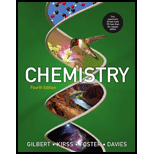
(a)
Interpretation: The role of Chlorine monoxide in the creation of Ozone holes in the stratosphere over the Earth’s polar region is given. Various questions based on the rate of reactions are to be answered.
Concept introduction: The change in the concentration of reactant or product with time is known as rate of reaction and
To determine: The rate of change of
(a)
Answer to Problem 14.37QP
Solution
The rate of change of
Explanation of Solution
Explanation
Given
The rate of consumption of
The chemical equation for the given reaction is,
The rate expression is given as,
The rate of formation of
Rearrange the above equation to obtain the value of rate of formation of
Substitute the value of rate of change of
Therefore, the rate of change of
Rearrange the above equation to obtain the value of rate of formation of
Substitute the value of rate of change of
Therefore, the rate of change of
(b)
Interpretation: The role of Chlorine monoxide in the creation of Ozone holes in the stratosphere over the Earth’s polar region is given. Various questions based on the rate of reactions are to be answered.
Concept introduction: The change in the concentration of reactant or product with time is known as rate of reaction and chemical kinetics deal with the rate of reaction.
To determine: The rate of formation of
(b)
Answer to Problem 14.37QP
Solution
The rate of formation of
Explanation of Solution
Explanation
Given
The rate of consumption of
The given reaction is,
The rate expression is given as,
The rate of formation of
Rearrange the above equation to obtain the value of rate of formation of
Substitute the value of rate of change of
Therefore, the rate of formation of
The rate of formation of
Rearrange the above equation to obtain the value of rate of formation of
Substitute the value of rate of change of
Therefore, the rate of formation of
Conclusion
The negative sign shows that the reactants are getting consumed in the reaction while the positive sign shows that the products are formed in the reaction.
Want to see more full solutions like this?
Chapter 14 Solutions
Chemistry
 ChemistryChemistryISBN:9781305957404Author:Steven S. Zumdahl, Susan A. Zumdahl, Donald J. DeCostePublisher:Cengage Learning
ChemistryChemistryISBN:9781305957404Author:Steven S. Zumdahl, Susan A. Zumdahl, Donald J. DeCostePublisher:Cengage Learning ChemistryChemistryISBN:9781259911156Author:Raymond Chang Dr., Jason Overby ProfessorPublisher:McGraw-Hill Education
ChemistryChemistryISBN:9781259911156Author:Raymond Chang Dr., Jason Overby ProfessorPublisher:McGraw-Hill Education Principles of Instrumental AnalysisChemistryISBN:9781305577213Author:Douglas A. Skoog, F. James Holler, Stanley R. CrouchPublisher:Cengage Learning
Principles of Instrumental AnalysisChemistryISBN:9781305577213Author:Douglas A. Skoog, F. James Holler, Stanley R. CrouchPublisher:Cengage Learning Organic ChemistryChemistryISBN:9780078021558Author:Janice Gorzynski Smith Dr.Publisher:McGraw-Hill Education
Organic ChemistryChemistryISBN:9780078021558Author:Janice Gorzynski Smith Dr.Publisher:McGraw-Hill Education Chemistry: Principles and ReactionsChemistryISBN:9781305079373Author:William L. Masterton, Cecile N. HurleyPublisher:Cengage Learning
Chemistry: Principles and ReactionsChemistryISBN:9781305079373Author:William L. Masterton, Cecile N. HurleyPublisher:Cengage Learning Elementary Principles of Chemical Processes, Bind...ChemistryISBN:9781118431221Author:Richard M. Felder, Ronald W. Rousseau, Lisa G. BullardPublisher:WILEY
Elementary Principles of Chemical Processes, Bind...ChemistryISBN:9781118431221Author:Richard M. Felder, Ronald W. Rousseau, Lisa G. BullardPublisher:WILEY





